
Introduction
For those of you that don't know, I love combo decks. I think one of the main reasons I got into Magic was the amount of combo decks that could potentially be used in the game. The idea of being able to combine a series of cards into an array of strange interactions that eventually win you the game just screams fun to me, especially when the general opinion is that I'm not supposed to be doing it! The first competitive deck in a card game that I ever played was a combo deck. The game was Yu-Gi-Oh and the deck was called Scientist Combo. I piloted the deck to a 5-3 top-25 finish of a 250-man tournament back when I still in middle school, which either says something about my deck construction abilities or the general play skill of the Yu-Gi-Oh players I faced; you can decide which. The deck itself was a simple "creature"-based combo deck that worked much like Magic's Cephalid Breakfast deck. Resolve two "creatures" as fast as possible, combine their abilities and win the game. The rest of the deck was simply searches and protection.
Of course, coming from a childhood of playing Yu-Gi-Oh, the sheer amount and complexity of combo decks in Magic did nothing less than captivate me. It is a personal belief of mine that combo decks add spice to a card game. Even if a combo is not degenerate, being able to win in one turn or play the game differently from the majority of players is just fun. It's like finding a cool glitch in your favorite video game, and I love finding glitches.
Combo Decks and Budget Legacy
If you cannot tell by now, this particular budget article is on budget combo decks. Yes, I know, Lion's Eye Diamond is still around $45. That doesn't mean we can't find some playable combo decks that don't use it. Decks which we can use to ruin the days of anyone that sits across the tables from us!
First however, is a quick rant on combo and budget Legacy. If you recall, in my first article I mentioned a quote by Drew Levin. Need a refresher? That's ok, I did too.
The problem with budget decks in Legacy is that they often try to be strictly inferior versions of the expensive decks... People want to play the 'good' decks, but by constraining the deck to fit your budget, you sacrifice a lot of what makes the deck good to begin with.
Regarding the budgeting of otherwise expensive decks I said...
This is a very big mistake that only really works in very specific situations.
So what are those very specific situations? Combos, man! One of the great things about combo decks is that your opponent must have some kind of interaction very early in the game or they just lose. Even beyond the interactions your opponent's deck has, sometimes it just doesn't matter. Sometimes they just don't have the interactions in hand. Sometimes combo decks just plain get there.
Let's talk statistics. Say you are playing a combo deck that can win on turn zero like Belcher or Spanish Inquisition. You shuffle up, draw your seven and see an opener that can do just that. What are the chances that your opponent will have any interaction whatsoever? Considering there is no such thing as a free discard spell that is also instant speed, and that Mental Misstep is banned, the only card that could possibly be used to stop you is the infamous Force of Will. Say your opponent has four in the deck. The chances that your opponent will have one Force of Will in their opening seven, not even taking into account whether or not they have a blue card to pitch, is 39.95%. This means, ignoring your own protection and counter magic, you have a higher than 60% chance to win the game right there, without even having to worry about a Force. Add in your own protection and the chances that you win sky rocket. In this sense there are times when the build of your combo deck simply doesn't matter as much - as long as the combo works and you can get it off at an early turn consistently, you are doing pretty good. This is why it is generally acceptable to budget some combo decks that could in some situations have more money put into them later on. Generally, a combo deck can perform much in the same way when you put $250 into it as when you put $1000 into it. It's just a matter of how you play the deck and the meta you play it in.
Of course, this turn-zero win is kind of a best case scenario. Playing a deck that has the ability to turn-zero win and then actually achieving it is kind of difficult. However, the point still stands. Sometimes your opponent doesn't have the Force of Will. Sometimes your opponent isn't even playing blue and just plain can't interact with you on a real level. It is the speed and unpredictability of combo decks that make them strong. Being able to prey on decks that try to play fair or catching an opponent off guard is what combo does best, and this can all be done for $250 or less. There are a lot of options here, some of which I really enjoy to the point that I am working on owning my own versions.
The decks in this article will be discussed starting with the cheapest, then moving up in price on until the most expensive. Keep in mind these are not your only options. These are just the combo decks that I feel deserve to be mentioned because of their cost, power, and just plain fun factor. So without further delay, let's get on to the lists!
Sac Land Tendrils
First on the list is a deck that I was made aware of by MTGSalvation user Jin15. I have since come to fall in love with the list he showed me, scouring the commons bins of the local shops near me in order to build my own copy. The deck is known as Sac Land Tendrils and for $100 it's one of the best bang for your buck combo decks out there.
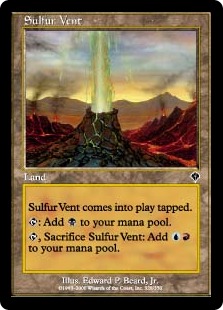
Price-
~$100
This is a perfect example of how good a combo deck can be even on an extreme budget. With sideboard this list will cost you around 100 bones, depending on where you shop and what cards you already own. This is pretty good considering it has the same key turn as traditional U/B storm and if played right can be just as durable. MTGSalvation user Jin15 has been a strong advocate of the deck and has spent a lot of time refining and testing it. The list shown is his take on the archetype for which he can be given much credit to developing in the legacy world. As quoted by Jin15:
Sac Land Tendrils is a Legacy format storm combo deck designed to be fast and competitive yet still extremely budget friendly. It's fairly simple and easy to learn to play, but like any storm combo deck it rewards practice and the skill of its pilot.
The origins of this storm combo archetype come out of the Pauper format deck known as "The Pauper Perfect Storm". I piloted TPPS for quite a long time and eventually came to the conclusion that not only was it one of the most consistent storm combo decks I've ever played, but that it could actually be very competitive in the Legacy format with some tweaking, tuning, and the addition of some powerful Legacy format cards. After a few months of work (and more play testing against Merfolk and Counter Top than I'd ever care to remember) I came up with what I feel is the most consistent and best performing competitive storm deck you can play in Legacy for $160 or less, and I gave it a name: Sac Land Tendrils.
The deck was named for its unique use of sac lands from the Invasion expansion, which can tap for one color of mana or be sacrificed for two different allied colors of mana, and for employing Tendrils of Agony as its primary win condition.
The list I chose to present in this article opts out of using Thoughtseize from the board and instead replaces it with Duress, which targets most of the same threats and costs much less. Also, I feel like Gitaxian Probe and Noxious Revival could both have a place somewhere in the main 60. This would warrant testing, though.
Overall, while I would disagree that the deck is easy to learn how to pilot, as I believe it is actually quite difficult to master especially in its blue matchups, it is strong and certainly worth its meager price tag. Much of the deck can be found in your local card shop's common bins for ten cents or less.
Spring Tide
Next on the list is a different kind of storm deck in terms of its color. Capable mono-colored storm decks are hard to come by but this blue storm list is certainly one of them.
| DeckMagic OnlineOCTGN2ApprenticeBuy These Cards | |
|---|---|
|
Lands-16 16 Island Creatures- 4 4 Cloud of Faeries Other Spells- 40 1 Brain Freeze 4 Brainstorm 3 Cunning Wish 4 High Tide 4 Ideas Unbound 3 Meditate 4 Merchant Scroll 4 Ponder 3 Retraced Image 3 Snap 4 Spell Pierce 3 Turnabout | Sideboard-15 1 Blue Sun's Zenith 1 Brain Freeze 1 Capsize 1 Chain of Vapor 2 Disrupt 3 Divert 1 Meditate 1 Pact of Negation 1 Rebuild 1 Snap 1 Turnabout 1 Wipe Away |
Price-
~$115
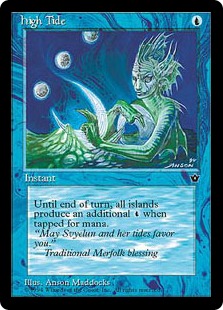
While the deck can certainly gain something by running Force of Will or Candelabra of Tawnos, the fact is it runs just fine without them. As long as you are smart about when you combo out, using Pact of Negation and friends for protection will be in enough in many cases.
Polymorph
Everyone likes really big creatures. This is especially true for us; well, at least for me. Most fatties used in legacy are creatures that can end a game on the spot and by themselves. Most of them are also relatively inexpensive. It is for this reason that many of the budget combo decks you will be introduced to will focus on resolving these fat creatures in different ways. Polymorph is a cheap mono-colored deck that was made possible (at least in mono color) by the release of the living weapons in the New Phyrexia set. Use either the living weapon Flayer Husk or the land/creature produced by Mishra's Factory or Wind Zendikon as an outlet to Polymorph or its stick version Proteus Staff. Since Emrakul, the Aeons Torn is the only creature in the deck you can congratulate yourself as you play the flying spaghetti monster for a measly three or four mana.

| DeckMagic OnlineOCTGN2ApprenticeBuy These Cards | |
|---|---|
|
Creatures-2 2 Emrakul, the Aeons Torn Other Spells-38 4 Daze 4 Flayer Husk 4 Lotus Petal 4 Spell Snare 4 Polymorph 4 Ponder 4 Preordain 3 Proteus Staff 4 Spell Pierce 4 Wind Zendikon | Lands-19 3 Ancient Tomb 12 Island 4 Mishra's Factory |
Price-
~$140
While it would knock the price up a bit, you always have the option to splash another color. The deck can easily splash white or black for additional protection and token producers like Beckon Apparition, Raise the Alarm, or Lab Rats. Chrome Mox can also be added for additional mana acceleration while Silence or Duress can be added as protection.
Living End
Not all combo decks are made popular in Legacy. While this deck did exist before the format's birth, Modern is what brought it into the spotlight.
| DeckMagic OnlineOCTGN2ApprenticeBuy These Cards | |
|---|---|
|
Creatures-27 4 Architects of Will 4 Deadshot Minotaur 3 Faerie Macabre 2 Ingot Chewer 2 Jungle Weaver 4 Monstrous Carabid 2 Shriekmaw 4 Street Wraith 2 Valley Rannet | Other Spells-13 2 Beast Within 4 Demonic Dread 3 Living End 4 Violent Outburst Lands-20 4 Blackcleave Cliffs 1 Blood Crypt 3 City of Brass 4 Copperline Gorge 2 Forest 1 Mountain 2 Swamp 3 Verdant Catacombs |
Price-
~$150
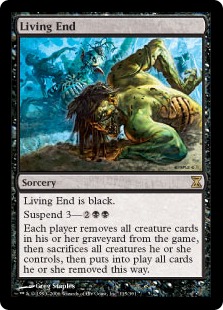
Hypergenesis
One of my all time favorites out of all the decks I am presenting in this article. This deck is fast, insanely fast, and also comes with built in protection against Force of Will.
Price-
~$175
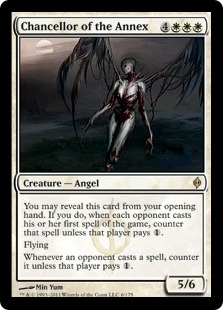
The thing I like most about this deck is its sheer speed. It has the ability to "go off" as early as the first turn of the game, while consistently setting fatties down by turn three. This speed is made possible by the eight Spirit Guide effects, four Chancellor of the Tangle, and three Gemstone Caverns, for a whopping total of 15 turn-one mana acceleration options. If you have a hankering for a fun and powerful combo deck that costs less than $200, put this at the top of your list.
Goblin Storm
Another deck straight out of modern and known for its speed, this is Goblin Storm.
| DeckMagic OnlineOCTGN2ApprenticeBuy These Cards | |
|---|---|
|
Creatures-7 4 Goblin Bushwhacker 3 Simian Spirit Guide Other Spells-38 4 Desperate Ritual 4 Empty the Warrens 4 Gitaxian Probe 4 Manamorphose 3 Peer Through Depths 4 Ponder 4 Preordain 3 Pyretic Ritual 4 Rite of Flame 4 Seething Song | Lands-15 4 City of Brass 4 Gemstone Mine 1 Island 1 Mountain 3 Scalding Tarn 2 Steam Vents |
Price-
~$185
Goblin Storm works much like many of the storm decks you may already be familiar with. Power out an early Empty the Warrens, which should net you around 10-14 goblins. If played early enough the opponent could just die within the next couple turns. If played in combo with Goblin Bushwhacker, the game is usually over then and there. This can all be done as early as the first turn of the game, which happens pretty often.
If anything, the deck could certainly be improved by adding in four Burning Wish, which would roughly increase the price by about $36, but increase its consistency dramatically. Peer Through Depths would likely be the cut in this situation.
Elf Ball
Elf Ball is a deck that has been getting a lot of talk lately with its top finishes in the recent SCG Open tournaments. The deck is a combo deck that has many incarnations based on what on would exactly like to accomplish with the vast amounts of mana it can produce.
Price-
~$185
(~$250 With Gaea's Cradle)
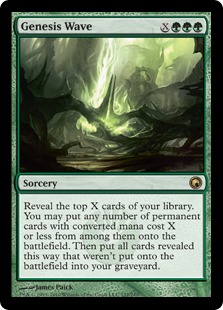
The deck can be constructed in many different ways. This is only one vision of the archetype that my team and I have developed. The deck can function even better if one replaces the Lodge with Gaea's Cradle, but this does add a significant amount to the overall price of the deck.
Kiln Fiend
Similar to the Berserk Stompy deck, Kiln Fiend is a creature-based combo/aggro deck that seeks to kill the opponent with fast and heavy hits provided by Kiln Fiend.
| DeckMagic OnlineOCTGN2ApprenticeBuy These Cards | |
|---|---|
|
Creatures-14 2 Countryside Crusher 4 Flamekin Harbinger 4 Grim Lavamancer 4 Kiln Fiend Other Spells-27 3 Aphotic Wisps 2 Assault Strobe 3 Duress 3 Gitaxian Probe 4 Inquisition of Kozilek 4 Lava Dart 4 Lightning Bolt 4 Manamorphose | Lands-19 2 Arid Mesa 4 Blackcleave Cliffs 4 Bloodstained Mire 3 Mountain 2 Scalding Tarn 3 Swamp 1 Blood Crypt |
Price-
~$220
Manamorphose, Gitaxian Probe and Lava Dart work to make the fiend as big as possible for as little mana as possible while discard, Bolts, Lavamancer, and Aphotic Wisps clear the way. Assault Strobe Is just stupid funny when it resolves, acting as a pseudo Berserk that usually results in lethal damage. Flamekin Harbinger finds your Kiln Fiends while Countryside Crusher both ensures that you don't hit dead draws and acts as an alternate win condition.
Berserk Stompy
Nothing new here. Very similar to the previous two decks presented.

| DeckMagic OnlineOCTGN2ApprenticeBuy These Cards | ||
|---|---|---|
|
Creatures- 4 Gladecover Scout 4 Kavu Predator 4 Silhana Ledgewalker 4 Skarrgan Pit-Skulk 4 Slippery Bogle 1 Xantid Swarm | Other Spells- 4 Berserk 4 Invigorate 4 Might of Old Krosa 4 Rancor 3 Green Sun's Zenith 2 Seal of Strength | Lands- 16 Forest 1 Dryad Arbor 1 Pendelhaven |
Price-
~$220
Berserk Stompy is a creature-based combo/aggro deck that runs small green creatures that come with either evasion or hexproof along with a lot of pump effects. The deck tries to win as fast as possible by pumping an early creature with cards like Might of Old Krosa then casting Berserk on the creature, which usually results in lethal damage. The deck runs multiple hexproof creatures to limit its vulnerability to removal spells. Berserk Stompy is unique compared to most combo decks I'm presenting because unlike the others it actually has the backup plan of just beating down the opponent. Kavu Predator combined with Invigorate can put on a pretty nasty clock that must be answered and anything with Rancor attached to it can make for some fun times.
Moldy Cheerios
This is one of my favorite decks of all time. Moldy Cheerios is the creepy child that came into being when the traditional Cheerios lists that ran Beastmaster Ascension made sweet sweet love to the classic Fluctuator combo deck.
Price-
~$225
This is a zero-cost creature combo deck that sacrifices protection for speed as it goes all out in the first one or two turns of the game. Cast Glimpse of Nature or Multani's Presence with a Chalice of the Void at zero and start playing guys. As you draw more and more you should run into more Glimpse or Multani's Presence to increase your draw. Draw your entire deck as you cast each creature and then kill your opponent with a lethal storm spell made possible by mana from Songs of the Damned. Since pretty much no one has ever heard of this deck, let alone seen it in action, ou can be pretty sure that game one will end with your opponent wondering how they just died to a bunch of Kobolds.
Shoal Infect
Shoal Infect is yet again another combo deck that was made famous by the Modern format. This deck is, in essence, what you get when you take the semi-popular Green/Black Infect Stompy lists and add a touch of cocaine.
| DeckMagic OnlineOCTGN2ApprenticeBuy These Cards | |
|---|---|
|
Creatures-7 4 Blighted Agent 2 Reaper King 1 Spellskite Other Spells-34 4 Blazing Shoal 2 Gitaxian Probe 4 Daze 4 Pact of Negation 4 Peer Through Depths 4 Ponder 4 Preordain 4 Searing Wind 4 Spell Pierce | Lands-19 1 Hall of the Bandit Lord 4 Inkmoth Nexus 12 Island 2 Tolaria West |
Price-
~$230
This deck works a lot like Berserk Stompy and Kiln Fiend decks that you may be familiar with. resolve Blighted Agent or Inkmoth Nexus. Next turn attack your opponent and pump the creature with Blazing Shoal discarding Reaper King (who is indeed a red creature) or Searing Wind to make the spell free. This causes your infect creature to deal lethal infect damage in one blow. Pact of Negation and Daze act as protection for your combo while the vast amount of cantrips find your combo pieces early on in the game. This deck can win on turn tw,o but its key turn is usually turn three.
Chant Life
Chant Life is an interesting take on the combination of two different combo decks in Legacy's history, Life.dec and Scepter-Chant.
| DeckMagic OnlineOCTGN2ApprenticeBuy These Cards | ||
|---|---|---|
|
Creatures-21 4 Daru Spiritualist 1 Emrakul, the Aeons Torn 3 Grand Abolisher 4 Mother of Runes 4 Nomads en-Kor 3 Shaman en-Kor 2 Task Force | Other Spells-19 3 Aether Vial 4 Condemn 3 Isochron Scepter 3 Sensei's Divining Top 4 Silence 1 Test of Endurance 1 Worthy Cause | Lands-20 2 Arid Mesa 4 Marsh Flats 10 Plains 4 Starlit Sanctum |
Price-
~$235

The well known "Scepter Chant" combo (Silence and Isochron Scepter) adds flavor and control to the deck. Soft lock your opponent out of the game as early as turn two then draw into a win condition or get them to concede on the spot. Another great synergy is the combination of Condemn with the Scepter. This gives you infinite pseudo Swords to Plowshares which you can use to buy time until you find your combo. It can then it can be used off of the stick on your own creatures to combo out like you normally would.
Grand Abolisher and Mother of Runes ensure you can combo safely without having to worry about a Swords to Plowshares ending your fun. Silence also works in much the same way, preventing your opponent from countering combo pieces or using removal.
Early incarnations of the deck did not run Sensei's Divining Top but after a lot of testing it was discovered that simply having redundancy in your combo was not enough. The deck needed a way to manipulate its draws, which top does when combined with the shuffle effect of the fetchlands that are included in the list.
Dredge
Dredge is commonly known as the boogie man of this format. That's not to say it doesn't deserve the title, but I like to think of it as more of a compliment than anything else.
| DeckMagic OnlineOCTGN2ApprenticeBuy These Cards | |
|---|---|
|
Lands-14 4 Cephalid Coliseum 4 City of Brass 4 Gemstone Mine 2 Tarnished Citadel Creatures-29 4 Tireless Tribe 4 Grave Troll 4 Putrid Imp 4 Narcoemeba 4 Stinkweed Imp 4 Ichorid 3 Golgari Thug 1 Flame-Kin Zealot 1 Sphinx of Lost Truths | Other Spells-17 4 Breakthrough 4 Bridge from Below 3 Dread Return 3 Careful Study 3 Cabal Therapy |
Price-
~$250
This deck is pretty famous by now but just in case you don't know how it works I'll give you the rundown. Dredge is an aggro synergy/combo deck. The deck works by replacing all of its draws with dredges, getting as much of its library into the graveyard as it can as quickly as possible. By discarding dredgers like Stinkweed Imp and Golgari Grave-Troll to Putrid Imp, Tireless Tribe, Breakthrough, and Careful Study the deck excels at what it does. Ichorid, and Narcomoeba are cheated into play, both of which trigger Bridge From Below when they flash back Cabal Therapy or Dread Return. Dread Return brings Flame-Kin Zealot into play for the aggro win.
This deck excels at beating control deck, as it can win without ever casting a single spell. At the same time, It can easily power out a turn two win by combining the insane dredge power that Breakthrough provides with a reanimation of Sphinx of Lost Truths, which continues the fun until you have enough Bridge From Below tokens to generate lethal Zombie damage and Cabal Therapy to protect the Dread Return that creates them. As long as the dredge pilot is smart, the deck can easily play around graveyard hate which makes it a serious force to be reckoned with and very likely to be the most powerful deck presented in this article. Dredge is my personal competitive deck, along with burn, and has gotten me top placements in many tournaments.
Conclusion
And there you have it, a list of a whopping thirteen legacy combo decks that can be gotten for $250 or less. I feel it's appropriate to end by noting that if you added the price of all of these decks together you would get a number close to $2400. If you compare that to the Team America deck that Alex Gonzalez piloted to a second place finish at SCG Las Vegas, which alone costs roughly $2,700, you can see just how cheap everything in this article is. For even less than what a top-tier Team America deck can cost you, you could buy thirteen combo decks with which you and twelve of your friends could challenge your local meta. It's your choice in the end, but I certainly know which of the two options I would go with.
Comments